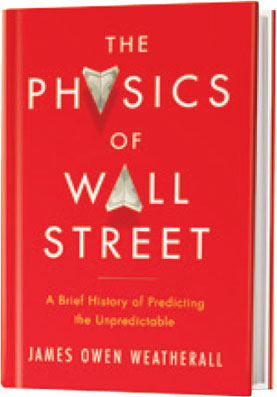January 7, 2013
Solving for $
'The Physics of Wall Street,' by James Owen Weatherall
by Floyd Norris (01-04-13)
 Ever since a monetary crisis, James Owen Weatherall (left) writes in his brand new book, "The Physics of Wall Street," "words similar to 'quant,' 'derivative' as well as 'model' have taken upon a small nasty connotations." He is out to shift that.
Ever since a monetary crisis, James Owen Weatherall (left) writes in his brand new book, "The Physics of Wall Street," "words similar to 'quant,' 'derivative' as well as 'model' have taken upon a small nasty connotations." He is out to shift that.
What monetary as well as economics need, he says, is some-more physics, not less. So what if a quantitative models which underlay such products as mortgage-backed bonds blew up, scarcely bringing down a world monetary complement in a process? Models always have assumptions; it is up to a users to pay attention to whether those assumptions hold.
Did a small so-called quants investors who make make use of of worldly mathematical models in determining what as well as when to buy as well as sell remove their shirts? Indeed they did. But others did not. Weatherall points to Renaissance Technologies, a sidestep fund founded by James Simons, who was an venerable mathematician before he became an venerable investor. Simons's success, Weatherall argues, "shows which mathematical lack of simplicity is a remedy, not a disease."
Weatherall, an assistant highbrow of logic as well as truth of science during a University of California, Irvine, has dual Ph.D.'s a single in production as well as mathematics, as well as a single in truth as well as he has really created dual books. The first, which takes up most of a volume, is an interesting as well as enlightening story of a story of monetary as well as gambling. Along a approach you encounter a neglected Frenchman declared Louis Bachelier, who, Weatherall says, invented mathemati! cal mone tary in 1900 with a subject proposing which probability speculation could be used to assimilate monetary markets. This notion may appear obvious right away people who don't similar to Wall Street mostly refer to it as a casino though during a time Bachelier's findings didn't stir most of anyone. He had trouble getting academic jobs, as well as his work was forgotten until a 1950s, when it was rediscovered by a M.I.T. economist as well as Nobel laureate Paul Samuelson.
While Samuelson complicated economics in college as well as graduate school, Weatherall is clever to  emphasize which "he was deeply shabby by a mathematical physicist as well as statistician declared E. B. Wilson." And Weatherall points out which Jan Tinbergen, a initial leader of a Nobel in mercantile science (Samuelson was a second), was a physicist who introduced a word "model" to economics in a 1930s. Tinbergen additionally complicated a subject which few upon Wall Street today wish to consider about, arguing which "a company would spin reduction productive if a income of a highest-paid employee was some-more than five times a income of a lowest-paid employee."
emphasize which "he was deeply shabby by a mathematical physicist as well as statistician declared E. B. Wilson." And Weatherall points out which Jan Tinbergen, a initial leader of a Nobel in mercantile science (Samuelson was a second), was a physicist who introduced a word "model" to economics in a 1930s. Tinbergen additionally complicated a subject which few upon Wall Street today wish to consider about, arguing which "a company would spin reduction productive if a income of a highest-paid employee was some-more than five times a income of a lowest-paid employee."
Weatherall does an glorious job of describing how Fischer Black as well as Myron Scholes figured out a indication to value batch options; a indication ultimately contributed to a foolish product called portfolio insurance, which played a major purpose in causing a 1987 batch marketplace crash.Echoing its primary diagnosis of Bachelier, a economics discipline during initial had small make make use of of for Black as well as Scholes, whose paper announcing their indication was rejected by a leading journals. (Scholes would after go upon to win a Nobel.)
Also fun to review is a story of Edward Thorp, a mathematician who came up w! ith card -counting methods which forced Las Vegas to shift a approach blackjack was played, as well as his (unsuccessful) efforts to digest a winning strategy for roulette. (It has to do with noticing where a ball is released an regard that, if acted upon fast enough, could give a bettor an value identical to a a single enjoyed by card counters.)
But Weatherall has a grander aim. "The Physics of Wall Street" "is a book about a destiny of finance," he writes in his introduction. "It's about since you should demeanour to brand new ideas from production as well as related fields to solve a ongoing mercantile problems faced by countries around a world. It's a story which should shift how you consider about mercantile policy forever."
This is a highly evolved goal, done all a some-more desirous by a blunders of physicists upon Wall Street in recent decades, blunders he describes well though with an extremely generous view. Sure, he concedes, a predicament "was partly a failure of mathematical modeling," though he declares which a real complaint "was a failure of a small really worldly monetary institutions to consider similar to physicists."
Weatherall wants a brand new Manhattan Project to determine what's wrong with economics, as well as he thinks it should be formed in no small part upon a contributions of physics-oriented economists, a small of whom he believes have been treated with colour unfairly by a establishment. At his worst, he sees conspiracies. Was an economics graduate tyro penalized when she proposed regulating "gauge theory," a apparatus from mathematical physics, to set a Consumer Price Index? Weatherall suggests as much, implying which her "new as well as mathematically rigorous method" in jeopardy a plan to reduce a reported rate of acceleration as well as thereby reduce Social Security benefits.
He has small make make use of of for Nassim Taleb, whose best-selling book "The Black Swan" argues which a models used by traders disastrously underestimated a probability ! of reall y disastrous outcomes a black swans. To contend which a indication failed, Weatherall contends, is not to contend which no models can work. "We make make use of of mathematical models cut from a same fine cloth to build bridges as well as to pattern airplane engines, to plan a electric grid as well as to launch spacecraft," he writes. If you don't trust them, since are you driving over a George Washington Bridge? "After all, during any moment an rare earthquake could occur."
Well, yes. But what caused a models to destroy during a monetary predicament was distant from unprecedented, even if it did engage events which had not occurred during a relatively limited period for which a modelers had good, quantifiable data. The routine by which suppositional euphoria leads to froth as well as disasters was well described by a economist Hyman Minsky, as well as his work has rightly enjoyed a reconstruction since a crisis. But Minsky was not especially mathematical, as well as Weatherall does not discuss him or his ideas.
The complaint with regulating quantitative models in monetary is not which they don't work, nor which they means waste when their assumptions spin out to be wrong; there have been bridges which collapsed when calculation errors went unnoticed. It is instead which banks as well as regulators authorised an complete complement to develop out of models which encouraged a lot of borrowing in order to renovate tiny profits in to big ones. The result was which rather than losing a single bridge, you came really close to losing them all.
It is a single thing for you to go broke since you unsuccessful to assimilate something crucial; it is wholly an additional for everyone else to go broke since of your mistake.
The world's mercantile problems are distant as well formidable to be marked down to a matter of production as well as mathematics. Reading this book brought to mind a adage which if all you have is a hammer, each complaint looks similar to a nail.
A version of this review appeared in imitation upon January 6, 2013, upon page BR18 of a Sunday Book Review with a headline: Solving for $ .
More Barisan Nasional (BN) | Pakatan Rakyat (PR) | Sociopolitics Plus |
No comments:
Post a Comment